As an Amazon Associate KitchenwareSets.com earns from qualifying purchases.
7 Warm Cozy Kitchen Ideas to Instantly Boost Comfort
Does your kitchen feel more like a sterile, functional lab than the true heart of your home? You have the necessary appliances, the countertops are clear, but something is missing. It’s a space for making food, not for making memories. It lacks that magnetic pull, that intangible feeling of comfort that makes family and friends want to linger long after the meal is over. It’s efficient, but it isn’t inviting.
This is a common struggle. In our quest for clean lines and modern efficiency, we often design the warmth right out of our kitchens. The result is a room that feels cold, impersonal, and disconnected from the lively, comforting role it’s meant to play. It becomes a pass-through zone instead of a destination, a place where chores are done rather than a place where life happens. You find yourself wanting a space that hugs you back, but you’re left with one that keeps you at arm’s length.
The solution is to create a warm cozy kitchen, which is an inviting and comfortable space that serves as the heart of the home by balancing beautiful aesthetics with everyday functionality. It’s about creating a welcoming environment not just through decoration, but through the deliberate layering of color, texture, light, and personality. We’ve helped countless homeowners transform their sterile workspaces into cherished gathering spots, and now we’re sharing our most effective strategies to help you do the same.
Does Your Kitchen Feel More Like a Sterile Workspace Than the Heart of Your Home?
A cozy kitchen is fundamentally a space that feels warm, inviting, and comfortable, serving as the true heart of the home for cooking, gathering, and creating memories. It achieves a delicate balance between beautiful aesthetics and practical functionality, making it a welcoming environment for everyone who enters. In my experience, a truly cozy kitchen is less about a specific style and more about a feeling—it’s the place everyone naturally migrates to, where conversations flow as easily as the coffee.
It’s a multi-sensory experience. It’s the visual warmth of earthy colors and natural wood, the physical comfort of a cushioned chair, the soft glow of layered lighting, and the personal touch of a favorite cookbook on the counter. It’s a space that reflects the people who live there, filled with personal touches that tell a story.
Unlike a purely functional or minimalist kitchen, which might prioritize stark simplicity and ease of cleaning above all else, a warm cozy kitchen prioritizes human connection and comfort. It’s designed to be lived in, not just looked at. This doesn’t mean it has to be cluttered or old-fashioned; a modern kitchen can be incredibly cozy with the right design choices. The goal is to create an atmosphere that encourages people to slow down, connect, and feel completely at ease.
7 Warm Cozy Kitchen Ideas to Instantly Boost Comfort
Here are 7 actionable warm cozy kitchen ideas, rooted in proven interior design principles, that can instantly boost the comfort and inviting atmosphere of your space. These strategies range from simple, budget-friendly decor updates to more involved changes, ensuring there’s a starting point for everyone. Each idea is curated to be both beautiful and highly practical for the modern home.
Whether you’re planning a full remodel or just want to make your current space feel more like home this weekend, these tips will guide you in layering the essential elements of a truly warm and welcoming kitchen. Get ready to transform your kitchen from a simple workspace into the most loved room in your house.
1. Embrace Warm Colors and Natural Textures
The fastest way to create a cozy atmosphere is by using a color palette of warm tones and incorporating natural, tactile textures. Warm colors like soft beige, creamy whites, earthy browns, and subtle yellows create an instantly homey and comfortable vibe. These hues are inviting and psychologically comforting, making a space feel like a warm embrace.
Think beyond just the walls. The real magic happens when you layer these colors with rich, natural textures. Materials like wood, stone, or even a brick-veneer backsplash introduce an organic character that sterile surfaces lack. Imagine the visual warmth of wooden cabinets, the rustic charm of a butcher block countertop, or the soft touch of wool or knit fabrics in seat cushions and curtains. These elements work together to soften the hard lines of a kitchen, adding depth and an undeniable sense of charm.
In my own designs, I’ve found that a two-tone color scheme can be particularly effective. By painting the lower cabinets in a slightly darker, earthy shade (like a deep mushroom or muted sage green) and keeping the upper cabinets light and airy, you can ground the space and add a layer of professional-level depth without making the room feel heavy or small.
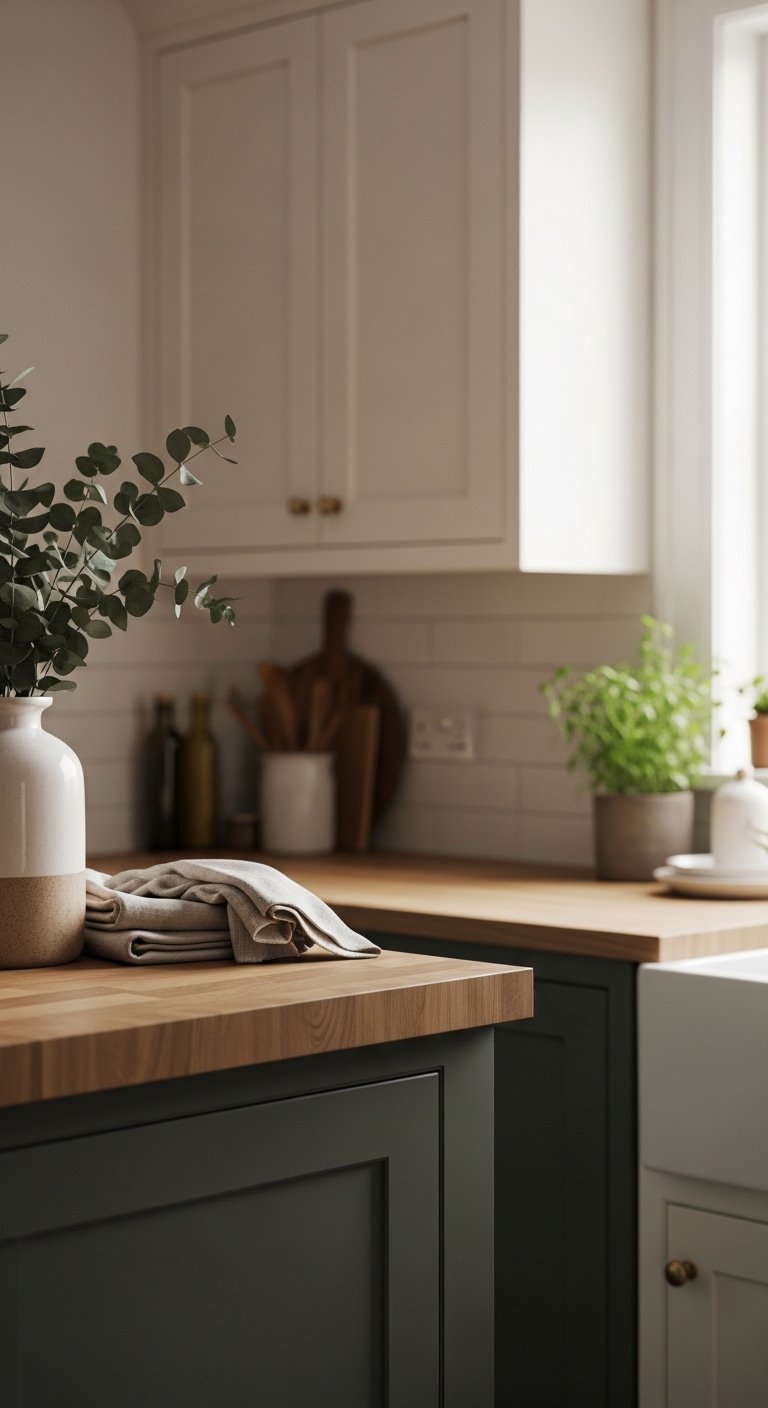
- Materials Needed: Your chosen paint color (e.g., Behr’s “Swiss Coffee” or Farrow & Ball’s “Stony Ground”), paint rollers/brushes, drop cloths, painter’s tape, wood cleaner, sample pots.
- Step-by-Step Directions:
- Test Colors: This is non-negotiable. Always start by painting sample swatches on your walls. Observe them at different times of the day—morning, noon, and night—to see how the natural and artificial light affects the tone.
- Prep Your Space: A great paint job is 90% prep. Clean your walls and cabinets thoroughly with a TSP substitute or degreaser. Tape off all trim, countertops, and backsplashes. Lay down drop cloths to protect your floors and furniture.
- Apply Primer (If Needed): If you’re making a drastic color change, like going from a dark color to a light one, a coat of high-quality primer is essential for achieving true color and even coverage.
- Paint the Walls: Using a roller for large areas and a brush for cutting in, apply two thin, even coats of your chosen warm color. Allow for the proper drying time between coats as recommended by the manufacturer.
- Introduce Texture: Once the paint is dry, begin layering. Plan to incorporate at least one natural texture. This could be as simple as adding a stone utensil holder on the counter or as involved as installing a small brick-veneer backsplash.
Pro-Tip: Don’t overlook the power of a two-tone cabinet scheme. Painting lower cabinets a slightly darker earthy tone (like a mushroom or deep sage) while keeping uppers light and airy can ground the space and add professional-level depth without overwhelming the room.
Pin this color palette to your ‘Dream Kitchen’ board!
2. Layer Lighting for the Perfect Ambiance
The key to a cozy atmosphere is layering a combination of ambient, task, and accent lighting to achieve a balance between functional and inviting. A single, harsh overhead light can make any kitchen feel like a sterile operating room. Layered lighting, on the other hand, allows you to control the mood and create a warm, welcoming glow.
Here’s the breakdown:
* Ambient Lighting: This is the overall illumination for the room, often from a central ceiling fixture or recessed lights. A charming pendant light over an island or dining area is a perfect source of ambient light.
* Task Lighting: This is focused light for your work areas. The most important and often overlooked type is under-cabinet lighting. It illuminates your countertops for safe and easy meal prep and eliminates shadows.
* Accent Lighting: This is used to highlight decorative features, like artwork or the texture of a backsplash.
One of the simplest yet most impactful changes I’ve ever made was swapping out all the cool-white light bulbs for warm-tone bulbs (those in the 2700K-3000K range). The difference is immediate and dramatic, instantly softening the entire room. Installing dimmer switches is the final step, giving you complete control to create a bright, energetic environment during the day and an intimate, cozy ambiance for evenings.
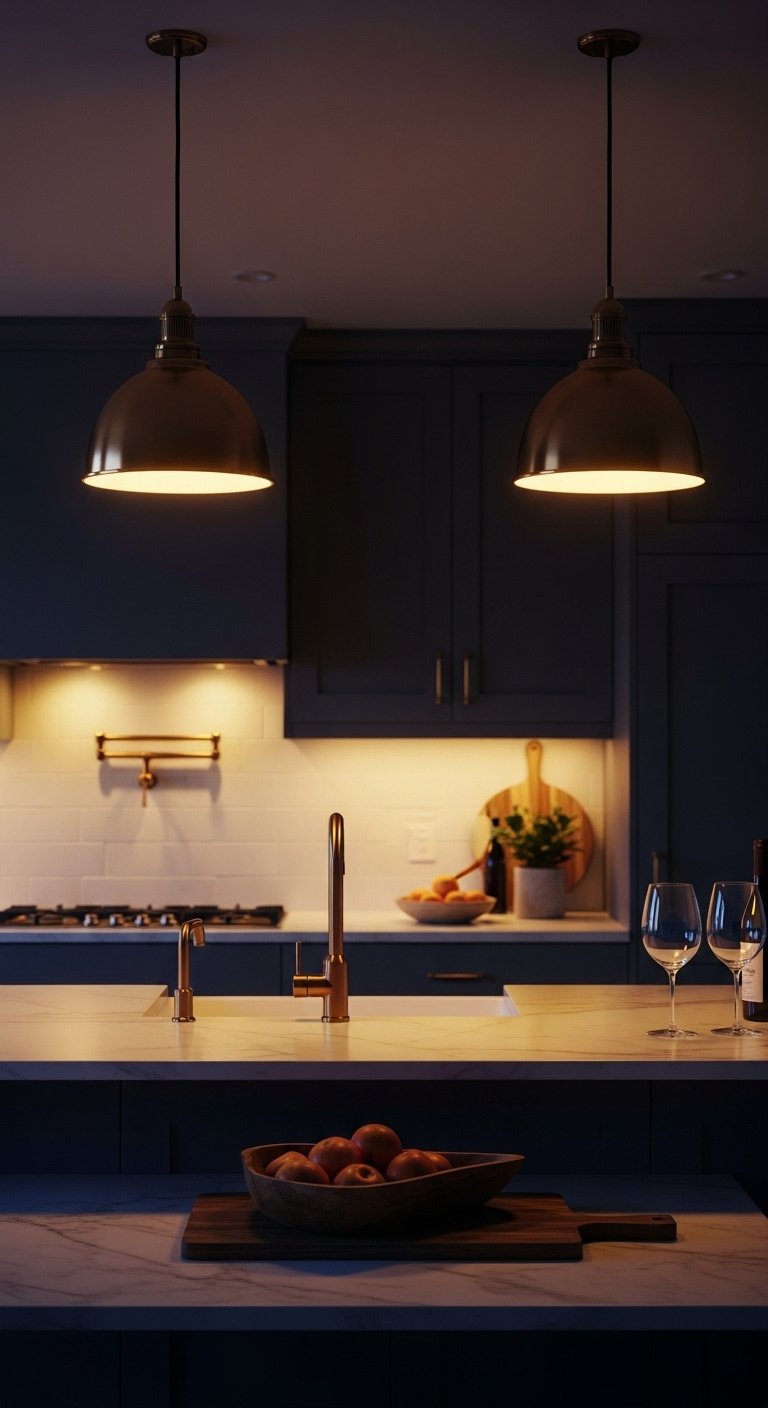
- Materials Needed: Pendant light fixture(s), LED under-cabinet lighting kit (strip or puck lights), warm-tone light bulbs (2700K-3000K), dimmer switches.
- Step-by-Step Directions:
- Assess Your Needs: Walk through your kitchen and identify your main work zones (sink, stove, prep counters) that need task lighting. Then, identify the social areas (island, table) that would benefit from softer ambient lighting.
- Install Ambient Lighting: Hang a statement pendant light or a series of smaller ones over your kitchen island or dining nook. This acts as the jewelry of the room.
- Add Task Lighting: Install a peel-and-stick or hardwired LED strip lighting kit under your upper cabinets. I can’t stress this enough: it’s a total game-changer for both meal prep and ambiance.
- Swap Your Bulbs: Go through your kitchen and replace any harsh, cool-white bulbs (often 4000K or higher) with warm-tone bulbs. This is the quickest and cheapest way to add instant warmth.
- Install Dimmers: If you’re comfortable with basic electrical work (or can hire an electrician), replace standard light switches with dimmer switches for your pendants and overhead lights. This allows you to fine-tune the mood from bright and functional to low and intimate.
Lesson Learned: Many people install bright overhead lights and stop there. The biggest mistake I see is neglecting under-cabinet lighting. Without it, you’re always working in your own shadow, which feels frustrating and uncomfortable. Adding it is the single most effective lighting change you can make for both function and coziness.
Save this lighting inspiration for your next kitchen update!
3. Weave in Natural Elements & Organic Textures
To create an authentic cozy feeling, you must introduce natural elements like wood and stone, along with organic textures from plants and woven materials. These elements bring the calming, grounding essence of the outdoors inside, softening the hard surfaces and straight lines typically found in a kitchen.
- Wood: This is a cornerstone of cozy design. Wooden cabinets, open shelves, or a classic butcher block countertop introduce an unmatched organic character and warmth.
- Plants and Herbs: A few potted herbs on a windowsill or a trailing plant on top of the cabinets adds natural beauty, a pop of fresh color, and can even improve air quality.
- Woven and Handmade Items: Textures from woven baskets, ceramic utensil containers, or rattan bar stools add incredible depth and visual interest. These pieces break up the monotony of smooth, manufactured surfaces and give the kitchen a more curated, collected feel.
In my experience, the magic is in the mix. Don’t be afraid to combine different natural materials. The slight imperfections in a handmade ceramic pot, the unique grain of a wooden cutting board, and the living green of a basil plant all work together to create a rich, layered look that feels personal and deeply comforting.
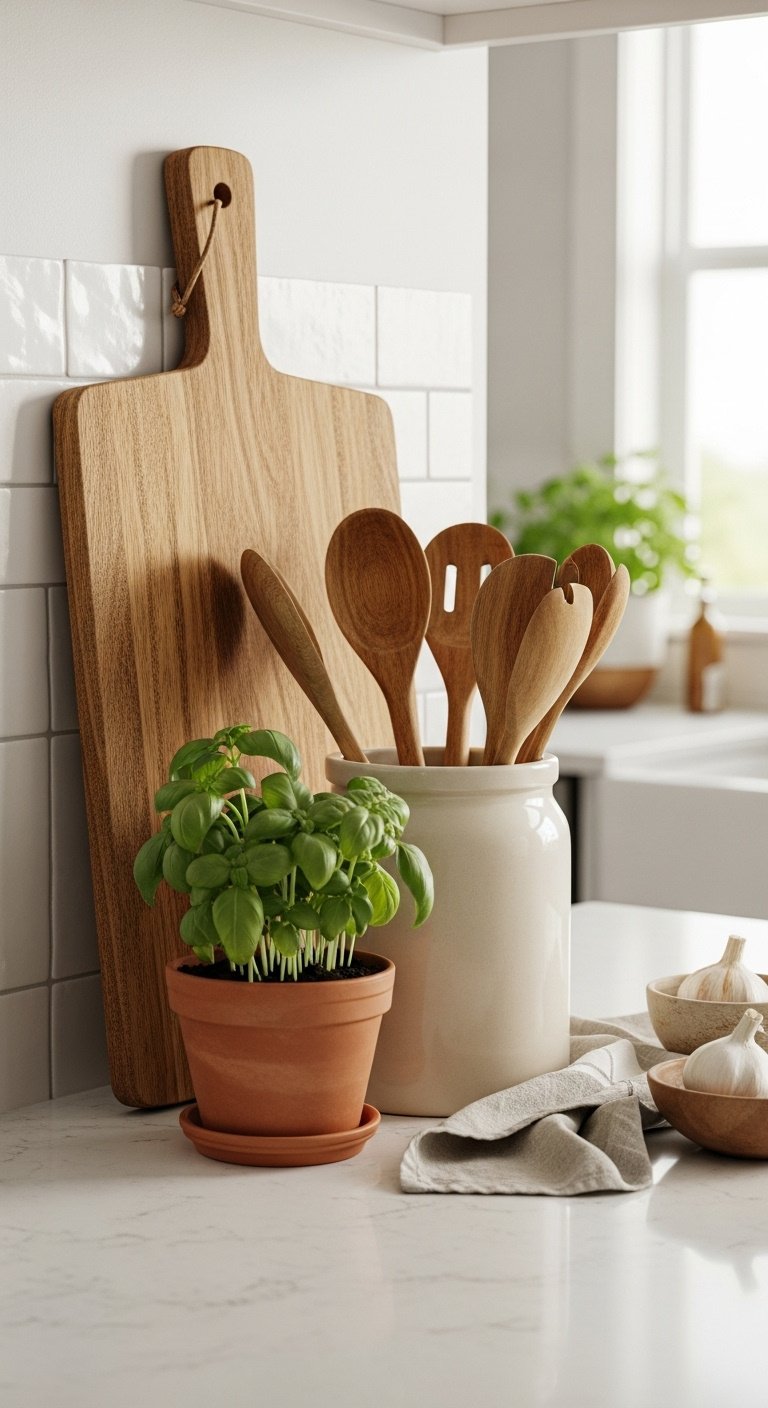
- Materials Needed: Potted herbs (e.g., basil, rosemary), ceramic pots, wooden cutting boards of various sizes, woven baskets for fruit or storage, a small wooden stool or riser.
- Step-by-Step Directions:
- Start with Greenery: The easiest first step is to place a few potted herbs on your windowsill or countertop. They add life, vibrant color, and wonderful fresh scents to your cooking space.
- Layer Wood Tones: Lean a collection of 2-3 wooden cutting boards in different sizes and wood tones against your backsplash. This is a classic designer trick that adds instant warmth and texture while still being practical.
- Introduce Woven Textures: Use a beautiful woven basket as a fruit bowl on the counter or to hold your dish towels. If you have an island, consider swapping out cold metal bar stools for ones with rattan or woven seats to add softness.
- Display Ceramics: Group a few ceramic containers or handmade pottery pieces to hold utensils, salt, or simply for decoration. The imperfect, handmade feel of these items adds immense character and charm.
Pro-Tip: Don’t feel you have to match wood tones perfectly. In fact, it’s better if you don’t! Mixing different woods (for example, a dark walnut cutting board on a light oak countertop) creates a more natural, collected-over-time aesthetic that significantly enhances the cozy, lived-in feel.
Love natural decor? Pin this idea for your kitchen!
4. Carve Out a Welcoming Seating Area
A truly cozy kitchen needs a dedicated spot with comfortable seating where family and friends can gather and connect. This transforms the kitchen from a purely utilitarian space into a social hub. It doesn’t have to be large; it just needs to be intentional and comfortable.
This welcoming spot could be a classic breakfast nook, a few cushioned barstools at an island, or even a small bistro table with a couple of chairs tucked into a corner. The key is comfort. Opt for soft seating options like upholstered chairs, plush cushions on a bench, or barstools with supportive backs.
For a truly intimate and space-saving solution, built-in benches or banquettes are fantastic. They create an instant “diner booth” feel that’s incredibly inviting. You can amplify the comfort factor by adding a few throw pillows or a soft blanket, making it the perfect spot for morning coffee, homework sessions, or just chatting while dinner is being prepared.

- Materials Needed: Cushioned bar stools or chairs, a small round table (for nooks), plush seat cushions, a couple of small throw pillows.
- Step-by-Step Directions:
- Identify Your Spot: Look for the most logical place for seating—an existing kitchen island, an unused corner that could become a nook, or a small, empty wall perfect for a narrow bench.
- Prioritize Comfort: This is crucial. If you’re using bar stools, choose ones with backs and upholstered or cushioned seats over hard metal or wood options. For a nook, select chairs with comfortable padding.
- Create a Banquette (for corners): For that ultimate cozy feel, consider a built-in L-shaped bench. You can find many ready-made banquette benches online or follow a simple DIY plan to build one.
- Add Softness: Immediately boost the comfort of any wooden chair or bench by adding plush cushions. Add one or two small throw pillows in a corner to encourage lingering and relaxation.
- Define the Space: Visually separate the seating area from the kitchen’s main work zones by placing a small, durable rug underneath the table and chairs.
Lesson Learned: Even the smallest kitchen can often fit a “perching spot.” From my experience, a single, comfortable stool tucked into the end of a counter is revolutionary. It creates a destination for a friend to sit and chat while you cook. It’s less about creating a full dining room and more about providing a clear invitation to stay awhile.
Tag someone you’d love to share a coffee with here!
5. Soften Surfaces with Textiles and Rugs
To make a kitchen feel truly homelike, you must add warmth and texture with soft textiles like rugs, runners, and curtains. Kitchens are full of hard surfaces—tile floors, stone countertops, wooden cabinets. Textiles are the perfect counterbalance, absorbing sound and adding a layer of softness and comfort underfoot.
A simple runner or area rug placed in front of the sink or stove can bring a splash of color, pattern, and much-needed comfort, especially on hard tile or wood floors. Look for durable, washable rugs designed for high-traffic areas; modern materials have made them incredibly practical additions to any kitchen.
Beyond the floor, other textiles play a key role. Simple dish towels, oven mitts, and window treatments in warm tones or subtle patterns can complement your overall design. Swapping out harsh vinyl blinds for a soft Roman shade or simple cafe curtains can dramatically soften the look of a window and create a layered, thoughtfully designed aesthetic.
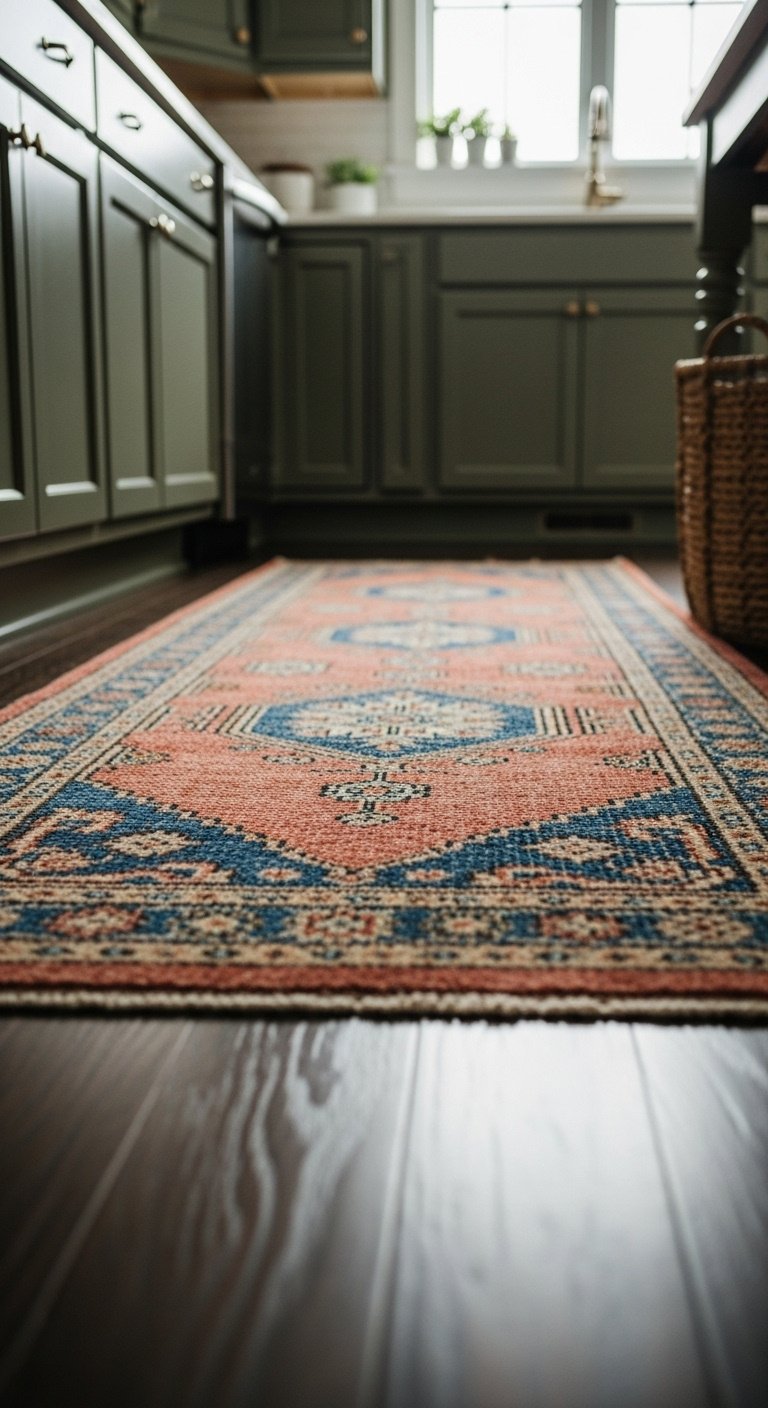
- Materials Needed: A durable, washable runner or area rug, a tension rod and simple cafe curtains (optional), coordinating dish towels and oven mitts.
- Step-by-Step Directions:
- Choose a Practical Rug: Select a runner for the main walkway, typically the space in front of the sink or stove. Look for materials that are durable and easy to clean, such as polypropylene, Ruggable-style washable rugs, or woven cotton blends. A good rug adds immense comfort underfoot during long cooking sessions.
- Hang Window Treatments: If you have a kitchen window, consider forgoing blinds for soft cafe curtains hung on a simple tension rod, or a fabric Roman shade in a warm color. This instantly softens the hard lines of the window frame.
- Upgrade Your Linens: This is a small change with a big impact. Replace worn-out, mismatched dish towels and oven mitts with a new, coordinated set in colors or patterns that complement your kitchen’s color scheme.
- Display with Intention: Don’t hide your beautiful new linens away. Instead, hang a nice dish towel from the oven or dishwasher handle, or fold a neat stack on an open shelf to add a soft, layered touch to your decor.
Pro-Tip: When choosing a kitchen rug, I always advise clients to opt for a low-pile design in a pattern or a darker color. From first-hand experience, it will be infinitely more forgiving of the inevitable crumbs and spills than a solid, light-colored rug, reducing your cleaning stress while still providing that essential cozy feel.
Find your perfect kitchen rug! Pin this for inspo.
6. Personalize with Meaningful Decorative Accents
A cozy kitchen feels lived-in, and the best way to achieve that is to personalize the space with decorative accents that reflect your personality and tell your story. This is what transforms a kitchen from a generic showroom into the unique heart of your home. Displaying personal items makes the space feel comfortable and uniquely yours.
This isn’t about adding clutter; it’s about curating with intention.
* Display items you love, like a collection of favorite cookbooks, a piece of art that makes you happy, or cherished family photos.
* Showcase vintage cookware or a collection of handmade mugs on an open shelf.
* Use a small chalkboard or letterboard for fun quotes, reminders, or a weekly menu.
Well-chosen accents create a warm and inviting atmosphere without overwhelming the space. The goal is to select a few items that are either beautiful, functional, or meaningful (and ideally all three!). This careful curation is the difference between clutter and character.
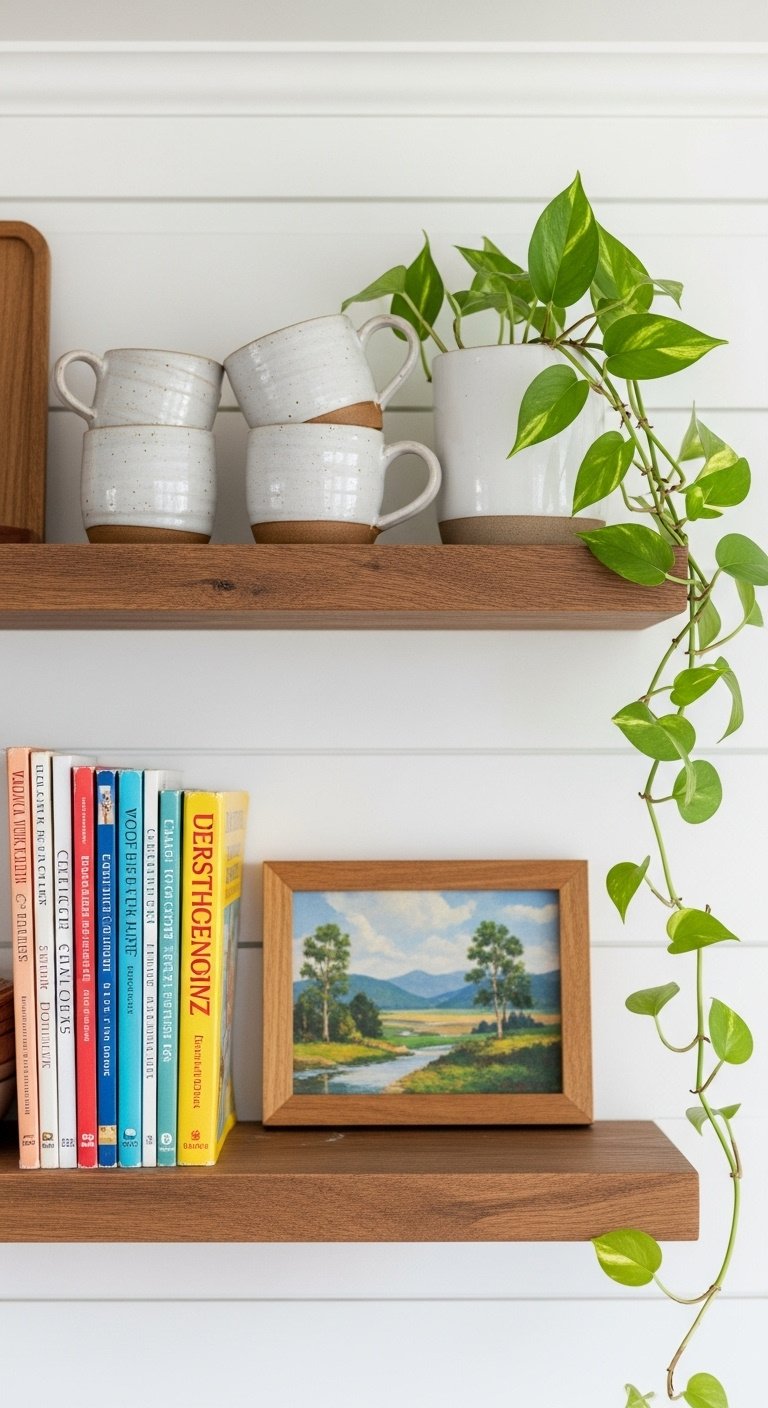
- Materials Needed: A favorite piece of artwork, a small framed photo, a stack of your most-used cookbooks, a floating shelf (optional), a small decorative tray.
- Step-by-Step Directions:
- Create a “Cookbook Corner”: Find a spot on your counter and neatly stack 3-5 of your favorite, most beautiful cookbooks. You can top them with a small plant or another decorative object to create a simple, charming vignette.
- Lean Some Art: Instead of putting another nail in the wall, try casually leaning a small, framed piece of art or a beloved family photo against the backsplash. It feels effortless and is easy to change out with the seasons.
- Corral with a Tray: Use a small wooden, marble, or woven tray to group everyday countertop items like your salt and pepper shakers, a beautiful bottle of olive oil, and a crock of utensils. This simple trick turns functional items into a curated, stylish display.
- Display a Collection: If you have a collection of pretty mugs, vintage plates, or small ceramic bowls, dedicate a small open shelf or a section of your counter to displaying them. This shows off your personality and adds unique character.
Lesson Learned: The absolute key to cozy, personal decor is curation, not clutter. I’ve learned that it’s far better to choose a few items that are genuinely meaningful or beautiful to you. A single piece of art you truly love will add more warmth and personality than ten generic, mass-produced “kitchen” signs ever could.
What’s your favorite thing to display? Share in the comments!
7. Choose Appliances & Fixtures that Blend In
For a truly cohesive and warm design, it is essential to invest in quality appliances and fixtures that seamlessly blend with your overall design scheme. When appliances and hardware clash with the cabinetry or color palette, they can visually clutter the space and disrupt the cozy atmosphere you’re trying to create. A unified look is calming and sophisticated.
While stainless steel has been the standard for years, there are now many warmer alternatives. Consider appliances in modern matte black, rich slate gray, or even custom panel-ready models that can be fitted with a front that perfectly matches your cabinetry for a completely integrated look. This creates a seamless, uninterrupted flow that is incredibly calming to the eye.
Don’t forget the smaller details! The “jewelry” of the kitchen—your cabinet handles, drawer pulls, and faucet—should also be chosen with care. Coordinating these finishes contributes significantly to a cohesive design. Furthermore, the backsplash serves as both a functional wall protector and a major design focal point. Choosing a material with inherent warmth and texture, like warm-toned zellige tiles, thin brick, or natural stone, can tie the entire room together.
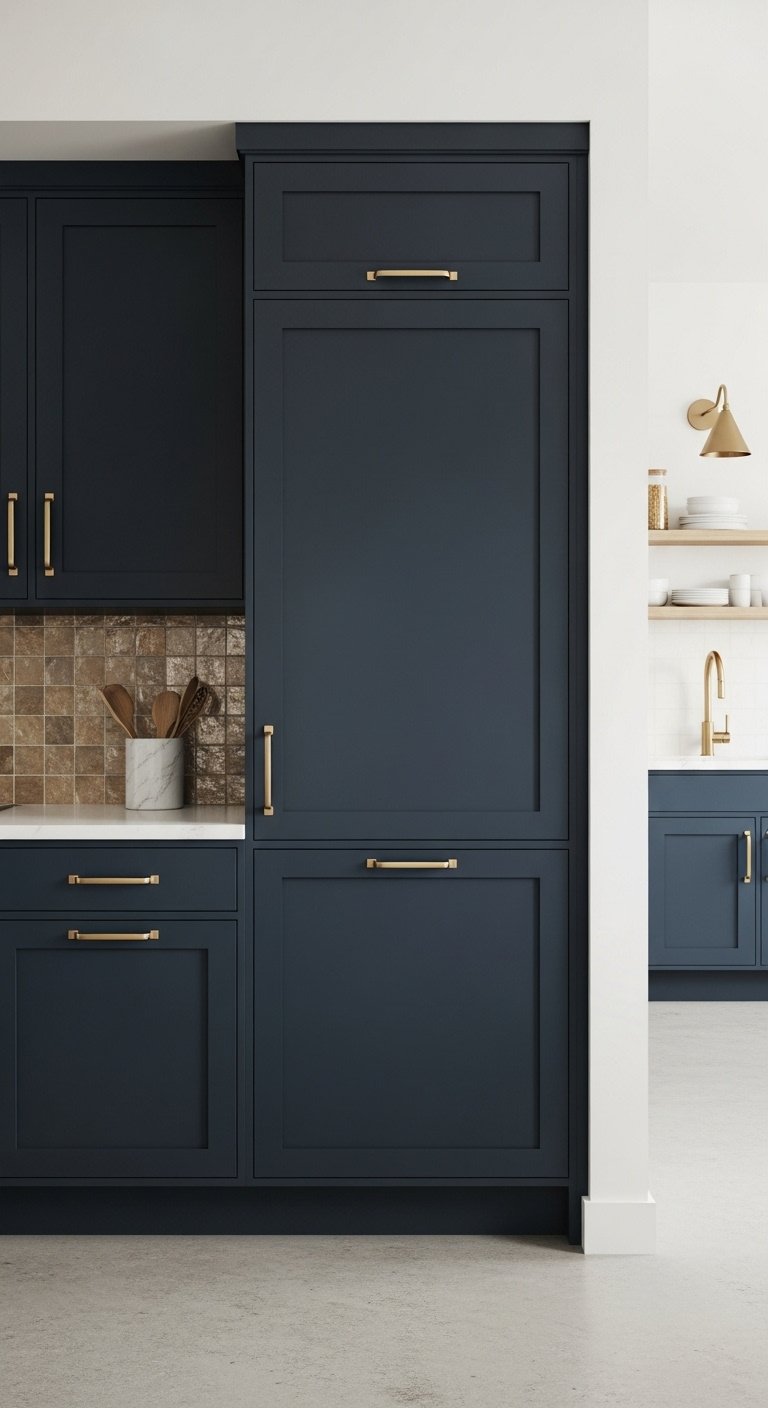
- Materials Needed: Samples of appliance finishes (if shopping), backsplash tile samples, cabinet hardware samples (knobs/pulls).
- Step-by-Step Directions:
- Consider Appliance Finish: When shopping for new appliances, look beyond standard stainless steel. Consider warmer alternatives like matte black, slate, or custom panel-ready appliances that allow them to disappear into your cabinetry for a seamless, high-end look.
- Select a Warm Backsplash: Choose a backsplash material that adds texture and warmth. Materials like zellige tiles (with their beautiful handmade variations), thin brick veneer, or natural stone are excellent choices for adding character.
- Coordinate Hardware: Ensure your cabinet pulls, knobs, and faucet finish complement each other and the overall tone of the room. Warm metals like unlacquered brass, copper, or matte black can act as the perfect finishing touch.
- Create a Mood Board: Before you commit to any big purchases, gather samples of your cabinet color, countertop material, backsplash tile, and hardware options. Seeing them all together in one place is the best way to ensure you’ll have a cohesive and warm final design.
Pro-Tip: When renovating, the backsplash is a prime opportunity to inject a huge dose of personality and warmth. While it serves a very functional purpose, I always encourage people to think of it as the kitchen’s main feature wall. A beautiful, textured, warm-toned tile can be the single element that ties the entire room together.
Pin this for your ultimate kitchen renovation goals!
Key Takeaways: Your Quick Guide to a Warm Cozy Kitchen
- Focus on a Warm Palette: Start with a foundation of soft beige, creamy whites, and earthy tones. These colors are psychologically comforting and create an instantly welcoming vibe.
- Layer Your Lighting: Ditch the single harsh overhead light. Combine overhead (ambient), under-cabinet (task), and accent lighting with warm bulbs and dimmers for ultimate mood control.
- Incorporate Natural Textures: Actively add materials like wood, stone, live plants, and woven baskets. These organic elements soften hard surfaces and add essential character.
- Create Comfortable Seating: Even a small breakfast nook or a pair of cushioned stools at the island provides a clear invitation for guests to stay, relax, and connect.
- Personalize Your Space: The final, most important layer is you. Display meaningful items like favorite cookbooks, personal art, or family photos to make the kitchen truly and uniquely yours.
People Also Ask About Creating a Warm Cozy Kitchen
What makes a kitchen feel cozy?
A kitchen feels cozy when it successfully blends warmth, texture, and personality. This is primarily achieved through warm color palettes (creams, beiges, earthy tones), the use of natural materials like wood and stone, layered lighting with warm-toned bulbs, soft textiles like rugs and cushions, and personal touches like art and cookbooks that make the space feel genuinely lived-in and welcoming.
What is a warm, cozy color to paint a kitchen?
Excellent warm, cozy colors for a kitchen include soft, creamy whites, warm beiges, earthy mushroom or greige tones, and subtle, buttery yellows. For a hint of color that still feels warm and inviting, consider muted shades like sage green or a soft, dusty blue. These colors create a comfortable and welcoming atmosphere that serves as a perfect backdrop for other cozy design elements.
How can I make my large kitchen feel cozier?
To make a large kitchen feel cozier, you must focus on creating defined zones and adding substantial texture. Use a large area rug to anchor a seating area or the central island, visually grounding the space. Incorporate substantial natural elements like thick wooden beams on the ceiling or a chunky butcher block countertop. Finally, using layered lighting with pendants and lamps will create intimate pools of light, breaking up the large, open volume of the room.
Final Thoughts
Your kitchen has so much potential to be the warm, beating heart of your home. Creating that cozy, inviting space isn’t about a massive, expensive overhaul overnight. It’s a rewarding journey of adding layers of comfort, texture, and personality over time. Start with one small change—swap your lightbulbs, buy a beautiful runner, or simply display your favorite cookbooks. You’ll be amazed at how quickly your kitchen starts to give you that warm hug you’ve been looking for.
Which of these ideas are you most excited to try first? Let us know in the comments below
